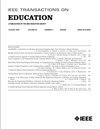重新思考课程中的性别包容:打开STEM教育的潘多拉盒子
IF 2
2区 工程技术
Q2 EDUCATION, SCIENTIFIC DISCIPLINES
引用次数: 0
摘要
贡献:本研究考察了工程学科本科生对课程课程中性别包容性的看法,重点关注课程设计的三个基本支柱:课程内容、教学方法和课程评估。背景:STEM领域,特别是工程领域的女性代表性不足,对经济体,特别是向知识经济转型的发展中国家的发展构成了挑战。虽然多种因素可能影响女性参与工程,但本研究特别关注以男性为中心的工程课程如何不同地影响男女学生对其教育经历的满意度和看法。研究问题:1)在课程内容、教学方法和评估过程的三大支柱上,男女学生对工程课程性别包容性的看法有何不同?2)随着学生的学习进展,学生对工程课程性别包容性的看法如何变化?这些变化在性别之间是否存在差异?方法:这项研究的重点是哈萨克斯坦,这个国家的工业发展和工程领域的性别多样性问题,尽管其科学劳动力总体上性别平等。它采用定量方法,结合以课程为重点的调查和推论统计测试。调查结果:调查结果揭示了性别对三大课程支柱的看法存在差异。随着学生学业的进步,女性对课程的满意度随着时间的推移而显著下降,而男性的满意度保持相对稳定。虽然这些发现表明课程因素可能会影响女性在工程教育中的经历,但需要进一步的研究来了解课程方面与其他影响因素(如社会因素和制度环境)之间的相互作用。本文章由计算机程序翻译,如有差异,请以英文原文为准。
Rethinking Gender Inclusion in Course Curricula: Opening Pandora’s Box in STEM Education
Contribution: This research examines undergraduate students’ perceptions in engineering disciplines toward gender inclusivity in course curricula, focusing on three essential pillars of curricular design: course content, teaching methodology, and course assessment.Background: The shortage of women representation in STEM fields, particularly in engineering, poses a developmental challenge for economies, especially in developing countries transitioning to the knowledge economy. While multiple factors likely influence women’s participation in engineering, this study focuses specifically on how men-centric engineering curricula affect differently male and female students’ satisfaction and perceptions of their educational experience.Research Questions:1) How do perceptions of gender inclusivity in engineering curricula differ between women and men students across the three pillars of course content, teaching methodology, and assessment processes?2) How do students’ perceptions of gender inclusivity in engineering curricula change as they progress through their studies, and do these changes differ between genders?Methodology: The study focuses on Kazakhstan, a country with industrial development and gender diversity issues in engineering despite overall gender parity in its scientific workforce. It utilizes a quantitative approach, incorporating a curriculum-focused survey and inferential statistical tests.Findings: The findings reveal gender differences in perceptions of the three curriculum pillars. As students progress through their studies, women’s satisfaction with the curricula significantly deteriorates over time, while men’s satisfaction remains relatively stable. While these findings suggest curricular factors may influence women’s experiences in engineering education, further research is needed to understand the interplay between curricular aspects and other influences, such as societal factors and institutional environments.
求助全文
通过发布文献求助,成功后即可免费获取论文全文。
去求助
来源期刊

IEEE Transactions on Education
工程技术-工程:电子与电气
CiteScore
5.80
自引率
7.70%
发文量
90
审稿时长
1 months
期刊介绍:
The IEEE Transactions on Education (ToE) publishes significant and original scholarly contributions to education in electrical and electronics engineering, computer engineering, computer science, and other fields within the scope of interest of IEEE. Contributions must address discovery, integration, and/or application of knowledge in education in these fields. Articles must support contributions and assertions with compelling evidence and provide explicit, transparent descriptions of the processes through which the evidence is collected, analyzed, and interpreted. While characteristics of compelling evidence cannot be described to address every conceivable situation, generally assessment of the work being reported must go beyond student self-report and attitudinal data.
 求助内容:
求助内容: 应助结果提醒方式:
应助结果提醒方式:


